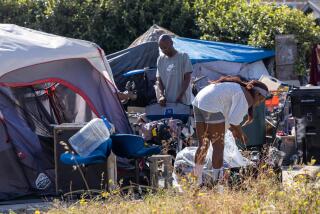New Shelter for Homeless in Bell Attracts Low Turnout on Opening
- Share via
BELL — Salvation Army workers waited anxiously Tuesday night for the homeless to arrive at the emergency shelter that opened in a federally owned warehouse here this week.
“I hope it’s (the attendance) better than last night,” said shelter coordinator Leroy Williamson, as he looked over a list of the 13 occupants who stayed at the facility when it opened Monday.
The 18,000-square-foot shelter will house up to 200 people, but Salvation Army officials who said they expected a low turnout during the first few weeks, set up about 40 cots Tuesday. The facility, which is tucked among several warehouses in the 134-acre Federal Supply Service Center on Rickenbacker Road, is the first homeless shelter in California to be on federal property.
While Williamson and three other workers made coffee and stacked cartons of soup, 16 homeless men and women arrived from four Salvation Army centers in downtown Los Angeles, Huntington Park and Compton.
“I guess the word got around,” Williamson said. “We even have a couple from last night that came back. I expect even more tomorrow.”
The homeless are scheduled to arrive at the warehouse at 6 p.m. and will be given a cot and a snack before being bused back to the other centers at 6 a.m. the following day.
Eian Allen, 29, who spent Monday night at the shelter and was the first person to check in, said he heard about the facility from the Salvation Army in Compton. Allen, who arrived in Los Angeles from New Jersey in 1976, said this was the first shelter he has slept in for nearly a year.
“A place like this is really needed around here,” Allen said. “I’ve just been sleeping outside, anywhere. I know of a lot more people from around Compton who would come here if they knew about it.”
But Lee Lewis, 35, who came from downtown Los Angeles, was a little leery.
“What do you mean we have to be out of here by 6?” she asked a friend. “What kind of shelter is this? It looks more like a jail.”
Occupants are not allowed to wander from the facility and lights must be out by 10 p.m., Williamson said. So far, he said, there have been no problems.
The shelter was suggested last winter by U. S. Circuit Judge Harry Pregerson, an outspoken advocate for the homeless. Pregerson, 64, enlisted the support of his brother-in-law and nephew, Guilford and Emerson Glazer, and a longtime friend and real estate developer, Nathan Shapell. The three men raised $50,000 to finance the center for three months. The General Service Administration, which oversees all federal property, is donating the space.
Bell officials initially opposed the idea of busing the homeless to Bell from other parts of Los Angeles County, but later the City Council gave its support to the shelter after the Salvation Army agreed to serve mainly the Southeast area’s homeless.
Capt. David Hudson, director of the shelter, stressed that those served will be from within five miles of Bell, but those from outside the area will not be turned away.
“Look around,” Hudson said Monday night as he turned toward rows of empty cots. “There’s no reason why we can’t take others. We have the space.”
Bell Councilman George Cole, a strong critic of the shelter, said he is still skeptical, but added: “I never had any illusions that they would be able to fill the shelter with homeless from a five-mile radius. If there is a need out there and they have the space they should use it.”
But Councilman George Mirabal, who maintains that the shelter was set up “to get the homeless out of Los Angeles,” said he is concerned that the low turnout will force the Salvation Army to bus the homeless from other areas in Los Angeles County.
The Salvation Army “can say all they want but they set up that thing to get the homeless out of L. A.,” he said. “It’s not our people who will go there, it’s L.A.’s people.”
Hudson said it is difficult to predict how many will come to the shelter in the next few weeks because the shelter is unlike any other Salvation Army facility for the homeless.
“Usually, you can just walk into a shelter, (but) here you have to register and then take a bus,” Hudson said. “That’s the biggest strike against it. But what makes this so important, even more than the numbers, is the cooperation between the local government, the Salvation Army and the federal government. This could open up (shelters) like this across the country.”
More to Read
Sign up for Essential California
The most important California stories and recommendations in your inbox every morning.
You may occasionally receive promotional content from the Los Angeles Times.










